TVs these days are quite affordable. You can get a 60” unit with 4K, HDR, and lots of cool features for (relatively) cheap. However, the sound quality will be rather modest. That is unless you’re ready to pay $1000+ for premium built-in speakers, of course. So, what’s your best move here? Well, how about investing in a speaker set? There are lots of options on the table!
And I’m not even talking about fancy 5.1 or 7.1 top-of-the-line kits that cost a fortune. Instead, our focus today will be on the best 2.1 speakers for TV. Easy to set up, lightweight, and compact, they can dramatically change the audio quality at a very reasonable price. So, let’s go ahead and check out what the market has to offer!
Table of Contents
Best 2.1 speakers for TV Review
1. Logitech – Best 2.1 speakers for LED TV
This company has been a prominent leader for decades, and it appeals to a wide range of potential customers. First of all, Logitech always offers different styles, designs, and packages to pick from. Secondly, the prices are almost always below the market average. For example, the Z625 speaker set is available at a very attractive price. And, you can choose between four configurations (the higher the cost, the more connectivity options you get).
More importantly, the audio quality is quite impressive. The lows and the mids are on par with the more expensive units, thanks to the premium subwoofer. The THX technology, in turn, does a decent job of creating the right audio experience for music and TV. Sadly, the high-end isn’t very clear and starts to sizzle when you crank the volume up. Other than that, Logitech is a sure pick.
The Pros:
- THX-certified for a wholesome audio experience
- Four different configurations to choose from
- A great pick if you’re on a tight budget
The Cons:
- The high-end tends to sizzle
Verdict
With a 200W output, THX tuning, and an affordable price, Z625 is a safe pick. You can use these speakers for a TV, computer, or connect to any other device through RCA or an Aux output. The low-end and mid representation is very accurate; the highs could’ve been a bit better, though.
2. Harman Kardon – Best wireless 2.1 speakers for TV
HK is one of the most eye-catching speaker sets out there. And, it looks great no matter where you put it, which is also very important. On top of that, thanks to the compact and lightweight body (the entire kit weighs less than seven pounds), you won’t have a problem carrying it around. I also want to mention the low-distortion design. In contrast to the previous speakers, the Harman set doesn’t hiss or sizzle at high volume levels.
Energy efficiency is part of the deal as well, by the way. The power output, compatibility, and quick controls are even more reasons to consider HK over the competition. There’s one major downside, though, and it has to do with durability. The engineering quality leaves a lot to be desired, and the company’s customer support isn’t always very client-oriented or helpful.
The Pros:
- Low energy consumption + minimal distortion
- Features an exquisite, eye-grabbing design
- Lightweight and compact: easy to carry
The Cons:
- Poor build/engineering quality
Verdict
If you’re looking for a bright and decent-sounding 2.1 speaker set, Harman Kardon might be right up your alley. It features an energy-efficient, low-distortion design and is very easy to set up. Unfortunately, durability isn’t its strongest suit, and some buyers complain about a short lifespan.
3. JBL – Best small 2.1 speakers for TV
Folks with thick pockets and a desire to get a premium-quality soundbar should pay extra attention to JBL. This device isn’t particularly cheap, and that’s its biggest downside. However, it’s got a long list of pros that compensate for the steep price. For example, with a combined system power of 300 watts, this bar can fill out a large living room; and you won’t have to crank the volume knob to eleven for that.
Another big pro is the wireless subwoofer. The 6.5-inch unit ensures a deep, ground-shaking bass response that’s simply not possible with the cheaper devices. Add advanced Dolby Digital Decoding for that surround-sound feeling, and you’ll see why JBL deserves a spot on the list. Again, it’s pretty expensive, but it will still be money well spent, especially for an audiophile slash home theater fan.
The Pros:
- Premium-quality, 6.5-inch woofer for deep bass
- Built-in Dolby Digital Decoding technology
- Strong power output: 300W combined
The Cons:
- Slightly on the expensive side
Verdict
If you’ve got extra bucks to spare, JBL’s 2.1 soundbar might be worth investing in. The lows, mids, and highs sound great no matter what environment you put them in. Believable Dolby, 300 watts of combined power, a class-leading woofer, and a sleek design turn this kit into a must-have.
4. VMAI – Best budget 2.1 speakers for TV
Speaker sets and soundbars are usually quite reliable and long-lasting. With that said, it’s always nice to know that your purchase is protected. Say, VMAI backs its product with a one-year warranty, and that’s a big advantage. This set will also be a great pick for people that put connectivity first. On top of the analog inputs – RCA and Aux – it includes HDMI and USB as well. Or, better yet, you should use Bluetooth to get the speakers connected.
Moving on, I want to mention the cool remote touch control panel. You’ll find it on the right side of the bar – use it to control the volume and shut the device off. My only complaint has to do with the bass frequencies. While the lows sound decent enough, they’re not as deep or impactful as, say, on the JBL system. However, for this price, VMAI is still one of the best deals on the market right now.
The Pros:
- Remote and touch control panel for quick adjustments
- Enhanced connectivity options: analog + digital
- Backed by a standard 12-months warranty
The Cons:
- The bass is a bit lacking
Verdict
Multiple input options (including digital and wireless), fancy remote controls, and a generous warranty – that’s what you’ll get with the VMAI 2.1 system. The bar and woofer come packed with lots of cables and an RC. The highs/mids sound great; sadly, the lows are a bit thin.
5. Samsung – Best Bluetooth 2.1 home speaker system with USB multimedia
Just like Logitech, Samsung needs no introductions. So, what can the average home theater owner expect from the HW-A450 kit? Will it be a worthy investment? The short answer – yes, it will. To elaborate: the soundbar features a central speaker (or, rather, channel) that makes the dialogues on TV a lot clearer and easier to understand. Along with that, it includes a long list of customization options and pre-set EQ modes.
Sports, movies, series, and video games – the Samsung 2.1 speaker set easily adapts to any task at hand to deliver the ultimate experience. Speaking of the game mode, it is compatible with PS4, Xbox One, and Switch and ensures perfectly-synced audio. Do keep in mind, though, that while Bluetooth is an option, it doesn’t always work the way you expect it to (takes some time for the TV to find it, for example).
The Pros:
- Includes a central channel/speaker for clear dialogue
- Lots of optimized, quick-to-switch EQ modes
- Takes very little time and effort to set up
The Cons:
- Minor issues with Bluetooth
Verdict
The central channel for dialogue enhancement, a wide range of EQ modes, and decent sound quality turn Samsung’s HW system into a bargain. Wireless (Bluetooth) connectivity can be a bit problematic at times, but the remote controller, bass boost, and sleek design make up for that.
Connecting TV Speakers to a Computer: a Step-by-Step Guide
One of the best things about modern-day speaker sets is versatility. As long as the inputs and outputs are matching, you can connect them to any gadgets/devices you own. Say, you’re not happy with how the generic tweeters plugged into the computer sound. Just grab the right cable, slide it right into the computer’s motherboard, and that’s it. I highly recommend using the USB interface (if supported).
As we’ll learn sooner from the Buyer’s Guide, it’s one of the fastest and most reliable options. HDMI is another great choice. Now, if it’s a really old computer, it probably won’t have HDMI cables. On the bright side, a newer unit, or a third-party soundcard/audio interface will definitely be more flexible in this regard. In the worst-case scenario (with no digital standards available), you can always go with good-old analog inputs/outputs.
Depending on the configuration, you’ll need a 3.5 jack to a 3.5 jack cable, a jack to an RCA, or, say, an RCA-RCA cable. In some cases, the only way to establish a connection will be through an adapter. These are available for cheap and solve most connectivity options. Keep in mind, by the way, that the 3.5 mm mini-jack on the back of the computer will be colored green.
As for RCA, it consists of two audio-in ports – red and white. At this point, it comes down to just plugging the cables in, turning the computer on, and enjoying the new speakers. Sometimes, Windows or Mac will welcome you with a message that says something like “new device detected” or “new driver detected”. Click yes, let the OS set everything up, and that’s it!
And one more thing: if you want to play audio on your computer/laptop through the TV’s built-in speakers, the best way to do that will be through the HDMI interface. The sound quality won’t be very impressive, though.
What kind of Speakers do I need for my TV?
There are really no right or wrong answers here. It all comes down to what kind of a set you’re looking for and how much money you’ve got. Say, if it’s a 2.1 speaker that you want, it will cost a lot less than a full-fledged soundbar with a subwoofer. The entry-level price on a decent-quality speaker set is $120-150, and it will be ten times better than whatever tweeters the TV comes with. Moving up the price ladder, we’ve got the 150-200-dollar options.
For that kind of money, you should expect premium audio quality, lots of connectivity options, a feature-packed RC, and, above all, accurate low-end representation. Again, a soundbar of similar traits is gonna be a bit more expensive. Folks in the market for an immersive surround sound experience might want to go with a 5.1 or even 7.1 kit. It won’t be exactly cheap, however. So, my advice is to find a compromise.
What I mean by that is a 2.1 bar with built-in Dolby Digital. Unless you’re a pro sound technician or have had some of the most expensive sound systems installed in your home, you’ll be quite surprised and satisfied by the Dolby technology that modern speaker kits have.
How to Connect a Stereo Speaker Set to a TV: a Detailed Manual
Most of what we talked about earlier when discussing how to connect TV speakers to a desktop computer/laptop applies here as well. The first thing you gotta do is check the available inputs and outputs on your speakers and the TV and find the best one. This is important: if it’s a 2.1 set, you’ll have to connect each individual speaker to the subwoofer, and then plug that woofer’s cable into the TV.
Sometimes, the configuration is different, but mostly, this is what most manufacturers go for. And don’t worry: the package will include at least one or two cables that will allow you to “pair up” the speakers both to an outdated and a brand-new television set. So, just run the speaker cables into the woofer and look at its back to see what kind of options are at your disposal.
RCA, Aux, optical and coaxial are the most common interfaces. Again, you’ll need a jack-to-jack, jack-to-RCA, or RCA-to-RCA cable, depending on what’s available. The TV might not automatically switch to the new speakers. That’s why you gotta go into its settings and choose the correct audio output. The same is true for Bluetooth: you activate it on the speakers and select it in the TV’s menu.
The Best way to Set up 2.1 Speakers for your TV
So, you finally bought a set of aftermarket speakers for your TV and got them connected. The last thing to do is to find the perfect spot for them. If it’s a soundbar, you just place it right below the TV or mount the bar on top of it on the wall. A pair of speakers, in turn, should just sit on both sides of the television, with the subwoofer also pretty close to the center. But what about the angle – what’s the best way to set the speakers up?
No matter how cheap or expensive the speakers are, the angle/perspective is going to have a pretty big impact on the sound. Ideally, you want them to create an imaginary triangle with the spot where you sit (say, the middle of the couch in the living room). The experts recommend placing them at a 25-30 degree. This has proven to provide a high-fidelity, clearly audible output. In a 5.1 kit, this will be a bit different, but the concept is still the same.
Also, I encourage you to experiment a bit with how far the speakers are from the walls. Remember: the closer they are, the more bass they’ll produce. Another thing to consider is the height. Ideally, the tweeters should be at ear level. As for configuration, there isn’t much to discuss here. If there’s a built-in EQ, you can play around with it a bit, but, in most cases, the factory presets are all you’re gonna need.
Buyer’s Guide
In the FAQ, we learned how to get the speakers connected to a computer or a TV. Plus, we talked about the best ways to configure/adjust them to your liking. Now it’s time to go over the most defining factors for any modern-day 2.1 speaker set. We’ll dive into the “volume wars”, check out the most common and useful connectivity options, the extra features, and, of course, discuss the importance of a proper-quality subwoofer.
#1: The Power Output/Watts
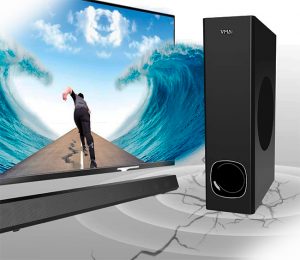
However, the vast majority of brands put the Peak Volume output in the specs to attract a bigger line-up of potential customers. On average, Peak is twice as high as RMS, but you shouldn’t pay much attention to it. That’s because when cranked up to 11, the soundbar/speakers won’t last for very long. Besides, the sound quality will be really low. Thus, with RMS, look for a set that puts out at least 150 watts (200W will be an even better deal).
#2: Connectivity Technology
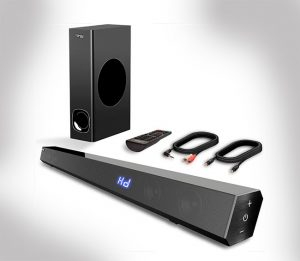
But, again, to get the fastest connection (and the highest audio fidelity), USB or HDMI will be more preferable. The best thing about the digital connectivity options – they’re very widespread. So, that TV in your living room definitely has HDMI (maybe even a pair of inputs) and probably also supports Bluetooth. Still, double-check before you buy the speakers so that you’re not disappointed later.
#3: Extras: EQ, Dolby, and RC
True, most TVs come with different presets, equalizer modes, and lots of adjustable settings. However, I want you to get a soundbar/speaker kit that’s got its own extras. First, make sure there are at least three different EQ modes for movies/TV, music, and games. Next, it would be best if there’s a bass boost button on the remote control. Speaking of the RC, it should be quick to respond and have a basic feature set.
A set of quick controls on the right side of the bar will come in handy as well. More importantly, see that the system supports the Dolby Digital technology for that “3D” audio experience. That’s pretty much it! As long as you get at least a couple of factory-optimized presets and a decent wireless control range, that should do it. Oh, and to hear the dialogues more clearly, the bar has to include a central channel.
#4: The Subwoofer
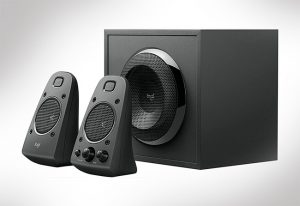
And, the rule of thumb here is – the bigger the size, the more “oomph” the bass will have. Say, a 4-inch subwoofer is a decent place to start, but if you want top-notch quality, go for something like 6 inches or more.
Conclusion
Statistically, the first thing on the average movie fan’s mind after buying a big TV is the sound quality. The factory speakers simply don’t cut it, especially if you like to play games and listen to music on your home theater system. That’s where aftermarket speakers come in. As we learned today, they don’t break the bank but still, do a great job of taking the audio experience to the next level.
If you don’t have a big budget for it, Logitech might be a reasonable choice. Harman, in turn, is a power-efficient set with a fancy design. With JBL, you’ll get 300W and lots of bass, while VMAI is all about connectivity and easy controls. Finally, fans of customization will like what Samsung has to offer. Got your favorite pick(s)? Share in the comments!


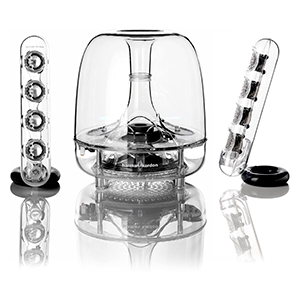

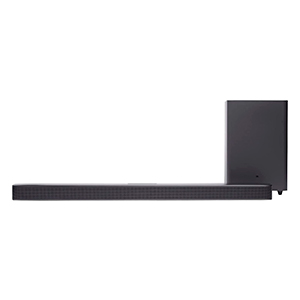

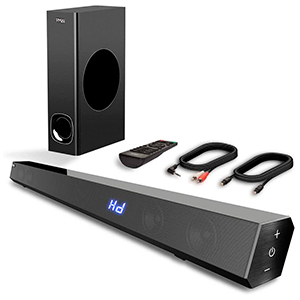

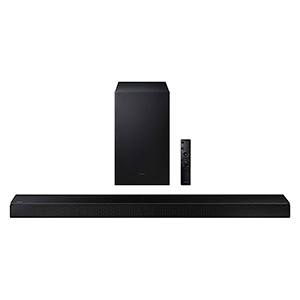

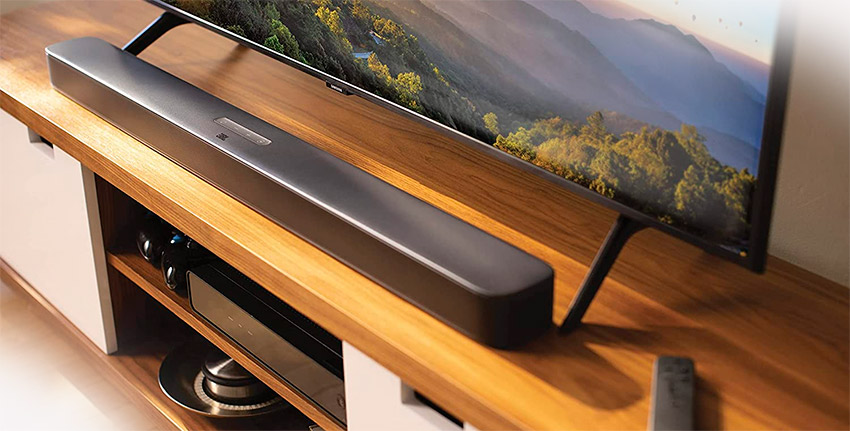
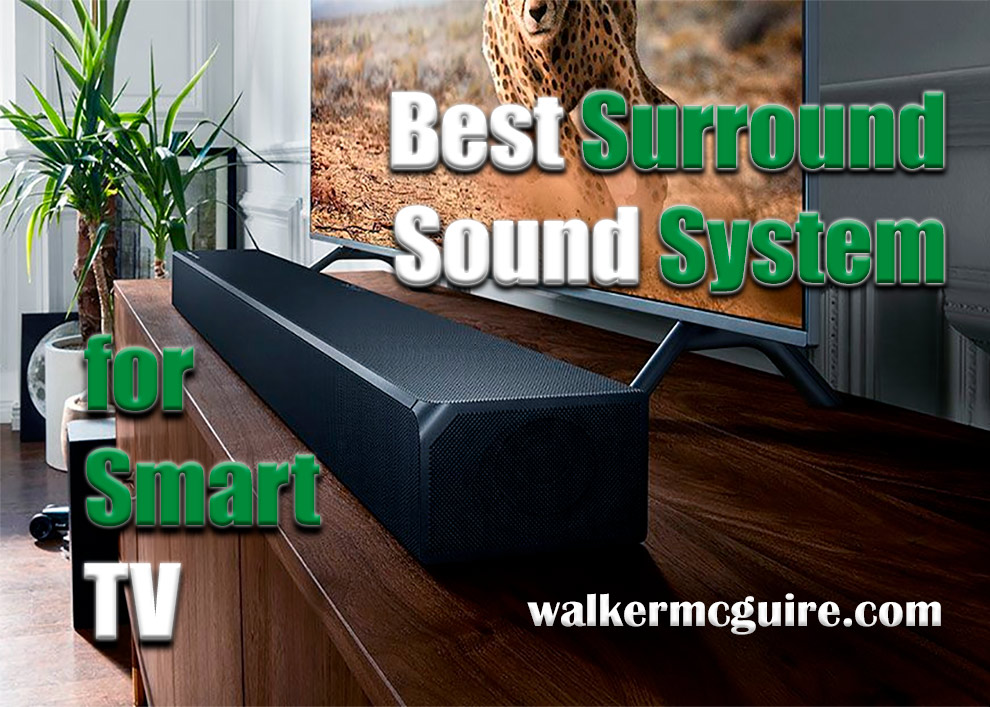
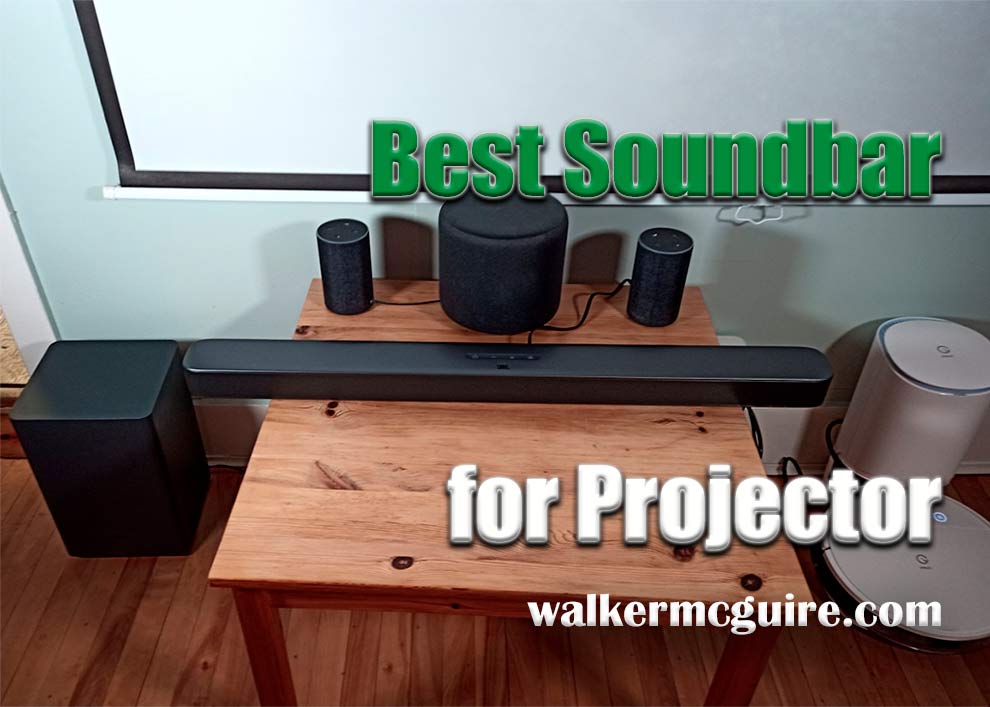

Leave a Reply